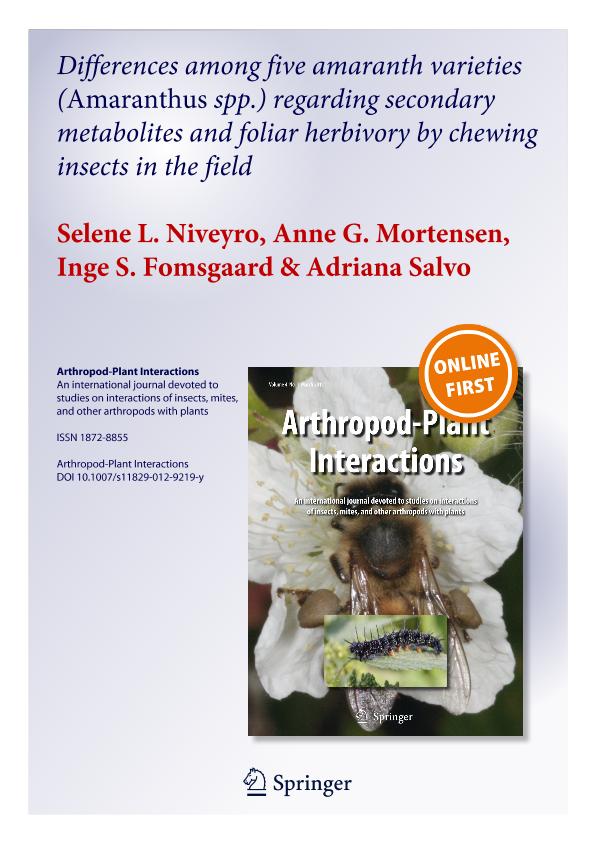Mostrar el registro sencillo del ítem
dc.contributor.author
Niveyro, Selene Leonor

dc.contributor.author
Mortensen, Anne G.
dc.contributor.author
Fomsgaard, Inge S.
dc.contributor.author
Salvo, Silvia Adriana

dc.date.available
2017-06-22T18:00:50Z
dc.date.issued
2012-09-05
dc.identifier.citation
Niveyro, Selene Leonor; Mortensen, Anne G.; Fomsgaard, Inge S.; Salvo, Silvia Adriana; Secondary metabolites of amaranth varieties (Amaranthus spp.) and its relationship with leaf damage by chewing insects in the field; Springer; Arthropod-plant Interactions; 7; 2; 5-9-2012; 235–245
dc.identifier.issn
1872-8855
dc.identifier.uri
http://hdl.handle.net/11336/18659
dc.description.abstract
In this study, we determined the abundance of secondary metabolites present in leaves of five varieties of Amaranthus, described the community of chewing insects observed in the foliage and also quantified damage by folivore insects in the field. Three flavonoid glucosides (rutin, nicotiflorin and isoquercitin), nine phenolic compounds (coumaric, vanillic, caffeic, syringic, ferulic, sinapic, protocatechuic, salicylic and 4-hydroxybenzoic acid) and three betalains (amaranthine, iso-amaranthine and betanin) were found to be present in amaranth leaves. Flavonoids appeared in of all varieties analyzed, with rutin being the most important. Betalains occurred only in some varieties and at different proportions, and nine phenolic acids were observed in all the varieties, with the exception of sinapic acid. Significant differences in the chemical composition of the varieties were noted. A total of 17 species of chewing phytophagous insects were observed through visual counting in Amaranthus plants, with the order Coleoptera being the most important and having the highest diversity of species. The degree of herbivory differed significantly among the varieties. Multivariate regression analysis indicated that the eight analyzed compounds detected in the plants had significant linear relationships with herbivory in the field. However, to draw any conclusions relating the amount of any compound to the degree of herbivory damage is premature at this stage of the research.
dc.format
application/pdf
dc.language.iso
eng
dc.publisher
Springer

dc.rights
info:eu-repo/semantics/openAccess
dc.rights.uri
https://creativecommons.org/licenses/by-nc-sa/2.5/ar/
dc.subject
Herbivory
dc.subject
Cultivars
dc.subject
Insects
dc.subject.classification
Ecología

dc.subject.classification
Ciencias Biológicas

dc.subject.classification
CIENCIAS NATURALES Y EXACTAS

dc.title
Secondary metabolites of amaranth varieties (Amaranthus spp.) and its relationship with leaf damage by chewing insects in the field
dc.type
info:eu-repo/semantics/article
dc.type
info:ar-repo/semantics/artículo
dc.type
info:eu-repo/semantics/publishedVersion
dc.date.updated
2017-06-16T15:53:05Z
dc.identifier.eissn
1872-8847
dc.journal.volume
7
dc.journal.number
2
dc.journal.pagination
235–245
dc.journal.pais
Alemania

dc.journal.ciudad
Berlin
dc.description.fil
Fil: Niveyro, Selene Leonor. Universidad Nacional de La Pampa. Falcultad de Agronomía; Argentina
dc.description.fil
Fil: Mortensen, Anne G.. Aarhus University. Faculty of Agricultural Sciences, Department of Integrated Pest
Management Research Centre; Dinamarca
dc.description.fil
Fil: Fomsgaard, Inge S.. Aarhus University. Faculty of Agricultural Sciences, Department of Integrated Pest
Management Research Centre; Dinamarca
dc.description.fil
Fil: Salvo, Silvia Adriana. Consejo Nacional de Investigaciones Científicas y Técnicas. Centro Científico Tecnológico Conicet - Córdoba. Instituto Multidisciplinario de Biología Vegetal. Universidad Nacional de Córdoba. Facultad de Ciencias Exactas Físicas y Naturales. Instituto Multidisciplinario de Biología Vegetal; Argentina
dc.journal.title
Arthropod-plant Interactions

dc.relation.alternativeid
info:eu-repo/semantics/altIdentifier/url/https://link.springer.com/article/10.1007%2Fs11829-012-9219-y
dc.relation.alternativeid
info:eu-repo/semantics/altIdentifier/doi/http://dx.doi.org/10.1007/s11829-012-9219-y
Archivos asociados
